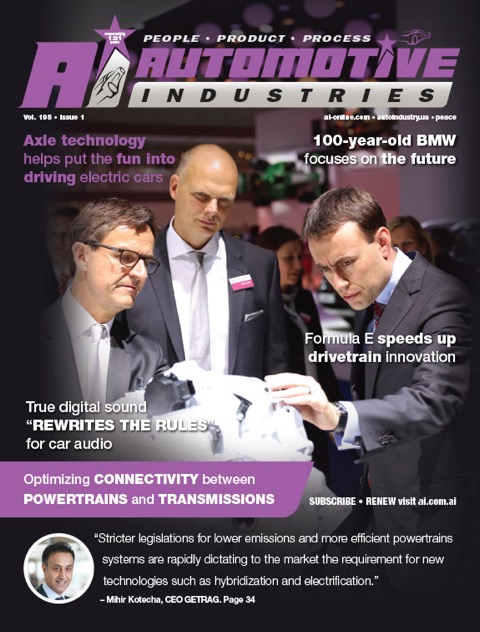
Greater synergies and improved connectivity between powertrains and transmissions are expected to be driven by the acquisition of GETRAG by Magna Powertrain in January 2016.
According to the two companies GETRAG’s product line complements Magna Powertrain’s expertise in engineering and manufacturing and provides new opportunities for growth. In particular, GETRAG is a leader in the market for dual-clutch transmissions (“DCTs”), a segment which is expected to experience high growth globally over the next decade.
“Expanding our business to provide complete powertrain solutions has been a strategic priority for us,” said Jake Hirsch, Magna Powertrain President. “We believe that GETRAG is an excellent fit in terms of product, technology, footprint, customers and people and look forward to working together to continue building on their history of innovation.” GETRAG brings an 80-year history of transmissions and technology leadership, offering a range of transmission systems including manual, automated-manual, dual-clutch, hybrid and other advanced systems. “We welcome GETRAG and its approximately 14,000 dedicated employees to the Magna family of companies,” said Magna CEO Don Walker. “With the completion of this acquisition, we continue to demonstrate our focus on a refined portfolio of strategic automotive product lines.”
“Under Magna’s ownership, GETRAG is well positioned to become even stronger,” said GETRAG CEO Mihir Kotecha. “I expect that the combined businesses will be even better positioned to realize opportunities being created in the powertrain segment by the need for improved fuel efficiency and reduced carbon emissions.” Automotive Industries (AI) put some questions to Jake Hirsch, President Magna Powertrain, and Mihir Kotecha, GETRAG CEO.
AI: What are the main synergies between the two companies?
Kotecha: We will have faster access to technologies needed in this very dynamic market, and a much stronger purchasing power by combining our efforts. There is also a lot of potential to create synergies for vertical integration, as well as systems and functional integration. We can also leverage engineering capabilities across the two groups, and will have the potential to share assets.
AI: How are your customers benefiting from the relationship between the two companies?
Hirsch: Both companies have a great reputation in the market, and GETRAG has a highly recognized brand. Going forward customers will benefit from the combination of GETRAG’s technology and product expertise in transmissions and Magna’s world-class operations and global footprint. Above all, together we will now be able to provide complete powertrain solutions.
AI: What are the dominant trends in the design of powertrains and gearboxes?
Kotecha: Stricter legislations for lower emissions and more efficient powertrains systems are rapidly dictating to the market the requirement for new technologies such as hybridization and electrification.
Transmissions will play a key role in mating traditional internal combustion engine-propelled systems with higher levels of electrification that supports the rapidly growing trend for hybridization. Our dual clutch transmissions enable the use of hybrid powertrains and provide the option of sporty or comfort driving modes. The system will also support requirements for low fuel consumption and lower emissions. Manual transmissions will continue to play an important role in the future due to their robustness, cost-efficiency and maximum direct response characteristics. Growing markets in the A/B segments will continue to predominantly use manual transmissions.
AI: Will we see products that combine the strengths of the two companies?
Hirsch: Our goal is to combine the strengths of both companies and offer OEMs complete powertrain solutions. Hybridization and electrification of vehicles are certainly areas which we will continue to develop, and where our combined skills, capabilities and resources will lead to even better overall results. This will also allow us to expand our existing product portfolio, particularly in the driveline area.
How does the acquisition affect Magna’s plans to expand into new markets? And what does it mean for the operations in China and India?
Hirsch: One of the major benefits of the acquisition with GETRAG is their significant presence in Asia, which will allow Magna to immediately take advantage of existing customer relationships with domestic OEMs including the addition of six new facilities in this region. China and India are important markets for both Magna and GETRAG today and we see huge growth opportunities there in the future. AI: What new products/systems will we see soon?
Hirsch: There are exciting times upon us. Magna’s activities currently include the design and manufacture of full electric and hybrid systems which we can now expand into full powertrain architectures. This will allow us to start looking at new ways to extend our AWD and 4WD capabilities.
LEFT: Mr Nils Schmid (right), finance and economics minister of Baden Württemberg at the GETRAG stand during the 2015 IAA.
BELOW: A Land Rover LR2 equipped with Magna’s FLEX4 all-wheel-drive (AWD) disconnect system that shuts off torque to the rear wheels (in the case of a front-wheel drive vehicle) when it isn’t required.
AI









More Stories
Acoustic sensor systems and Fraunhofer measurement technology for in practical testing ͏
OSI Systems Receives $10 Million Order for Cargo and Vehicle Inspection Systems
Mitsubishi Electric Automotive America Launches Guardian Generation 3 Trial with Seeing Machines in North America